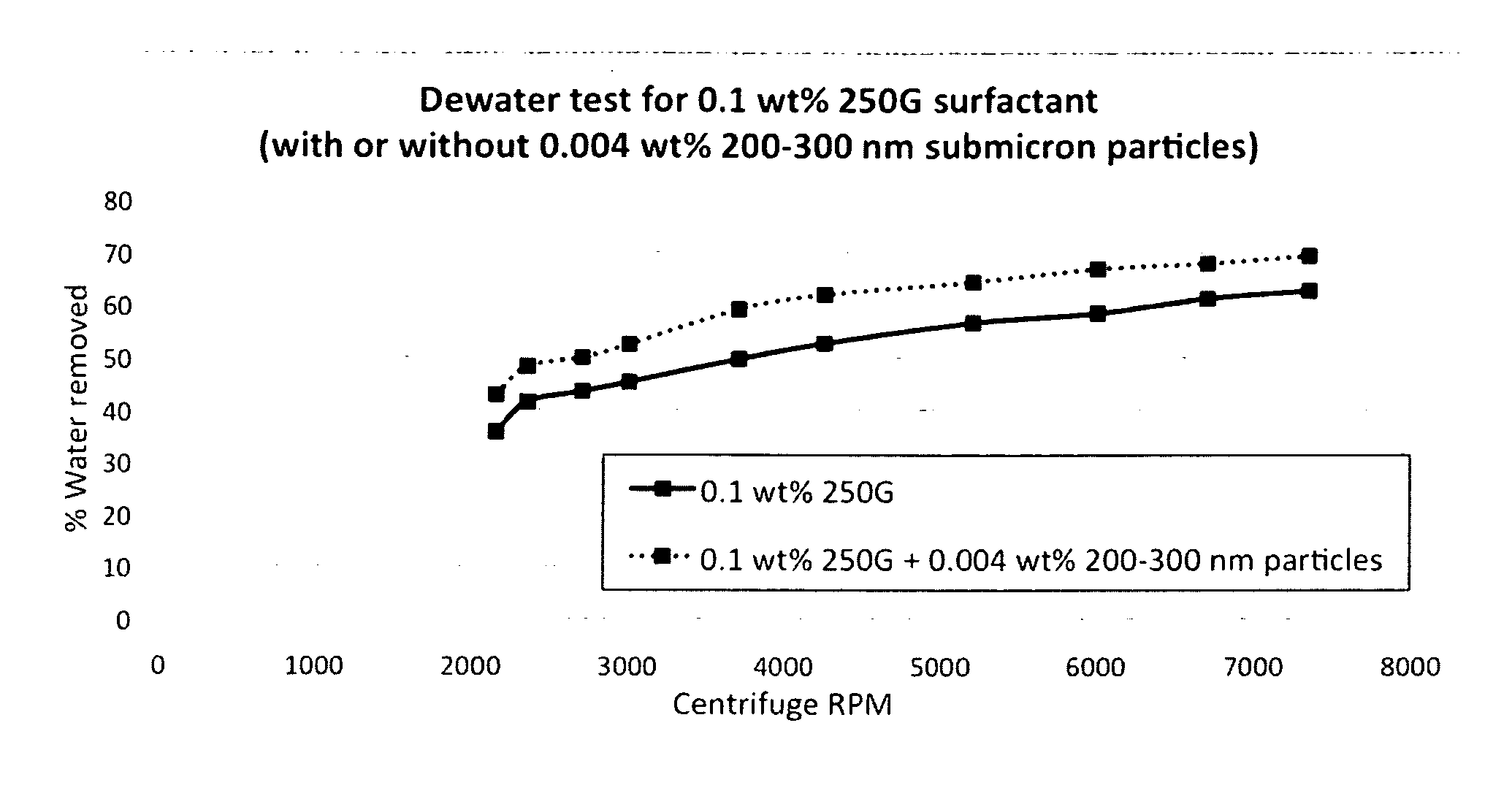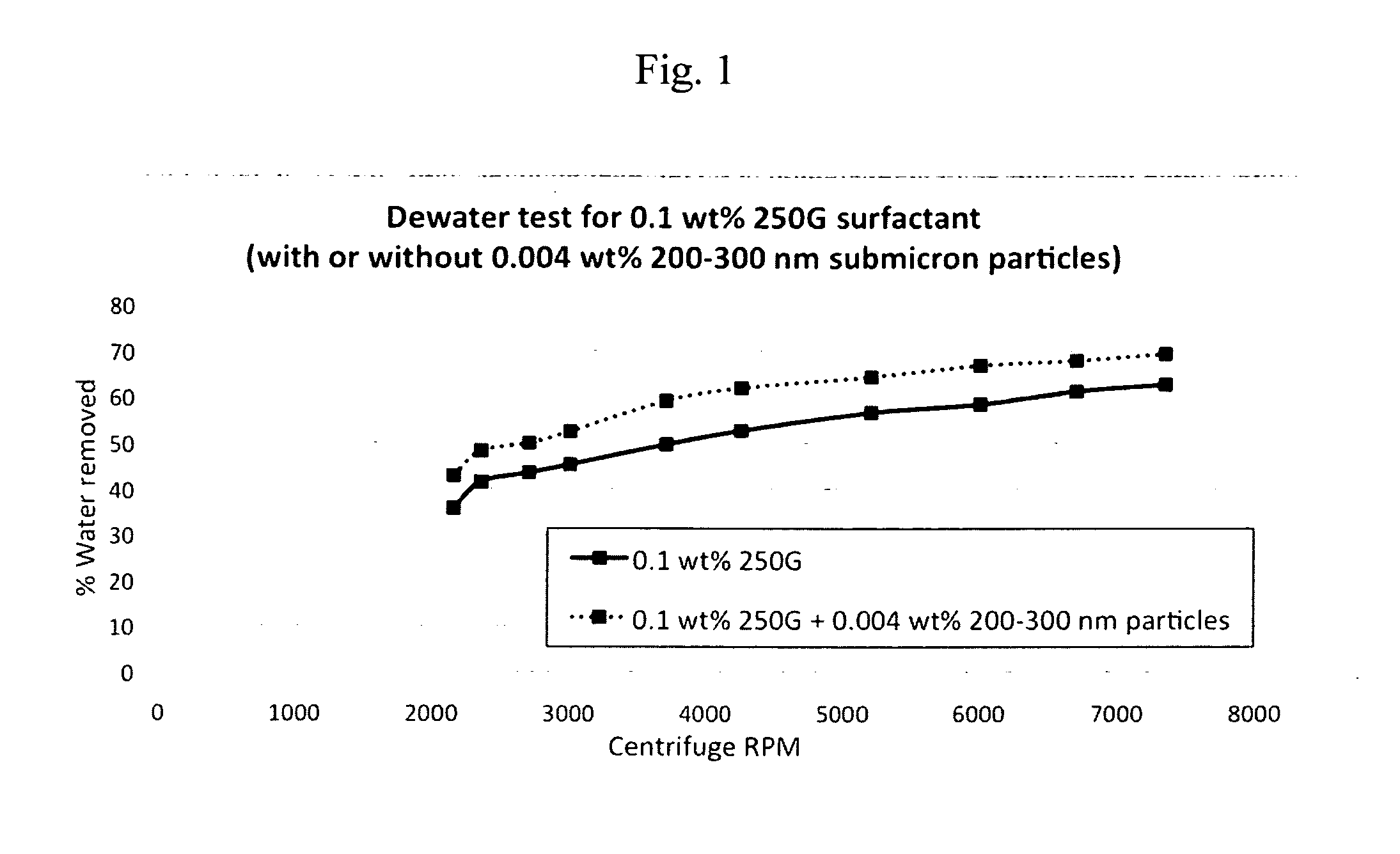Submicron particles surfactant method for improved oil recovery from subterranean reservoirs
a technology of subterranean reservoirs and surfactants, which is applied in the direction of fluid removal, chemistry apparatus and processes, borehole/well accessories, etc., can solve the problems of not being required or desirable for fluids used in particular treatment operations
- Summary
- Abstract
- Description
- Claims
- Application Information
AI Technical Summary
Benefits of technology
Problems solved by technology
Method used
Image
Examples
example 1
[0085]To determine the effect of submicron particles on existing surfactant based stimulation and EOR treatment fluids, laboratory tests were performed as follows: a) two limestone cores (characteristics provided above) were completely saturated under vacuum with a light crude oil from a production well in the Eagle Ford Shale, 38 degrees API gravity, and the weight of oil imbibed measured (usually in a range of 5-5.5 grams); b) one core was immersed into a dispersion containing 0.2 wt % RC27, a commercial surfactant formulation used in oilfields, with 2 wt % potassium chloride (KCl) as brine base, while the second core was immersed into a dispersion that contained the same concentration of surfactant product and brine, and also additionally 0.004 wt % silica submicron particles having a particle size of 200-300 nm range and a specific surface area of 200 m2 / g; c) each core was placed in a separate Amott cell, which is a device that includes a volumetric burette attached to the top ...
example 2
[0087]The effect of submicron particles on oil recovery processes was further explored. These tests used the same testing procedure as those in Example 1. The oil used in these tests was a medium gravity crude oil from a carbonate reservoir of the West Texas Permian Basin. The surfactant was StimMax C, a commercial surfactant product used in oilfield applications. Two types of submicron particles were used: lanthanum gallate (size 300-600 nm, specific surface area 4-8 m2 / g) and silica (size 200-300 nm, specific surface area 200 m2 / g). Other differences in conditions and parameters are noted in Table 2 immediately below.
TABLE 2% Oil recovery by chemical soaking of limestone cores containing a West Texas medium gravity crude oilSurfactant + ParticlesSurfactant OnlyParticles Only0.2 wt % StimMax C,0.2 wt % StimMax C0.008 wt % particles0.008 wt % particlesSubmicron Particle TypeConditions12.9032.5Lanthanum gallate, 300-600 nm50 C., 64 hours9.5032Silica, 200-300 nm50 C., 18 hours
[0088]Re...
example 3
[0091]In an experiment the dewatering performance of dispersions containing a surfactant formulation alone or also additionally submicron particles were evaluated. Limestone cores were soaked until they were saturated with a base brine of 2 wt % KCl. Then in the presence of the dispersions they were centrifuged at a series of increasing speeds, and the percentage of brine removed recorded. The surfactant chosen was a commercial formulation called 250G, and it was made at 0.1 wt % of total dispersion. The submicron particles were silicon oxide 200-300 nm in particle size, 200 m2 / g in specific surface area, made at 0.004 wt % of total dispersion.
[0092]The results, shown in FIG. 1, demonstrate the superior performance of the dispersion containing 0.004 wt % submicron particles. It performed better than the surfactant only dispersion, removing 6-10% more brine at every centrifugation speed.
[0093]Surfactant dispersions generally promote removal of water and aqueous-based fluids due to th...
PUM
| Property | Measurement | Unit |
|---|---|---|
| Fraction | aaaaa | aaaaa |
| Time | aaaaa | aaaaa |
| Time | aaaaa | aaaaa |
Abstract
Description
Claims
Application Information
 Login to View More
Login to View More - R&D
- Intellectual Property
- Life Sciences
- Materials
- Tech Scout
- Unparalleled Data Quality
- Higher Quality Content
- 60% Fewer Hallucinations
Browse by: Latest US Patents, China's latest patents, Technical Efficacy Thesaurus, Application Domain, Technology Topic, Popular Technical Reports.
© 2025 PatSnap. All rights reserved.Legal|Privacy policy|Modern Slavery Act Transparency Statement|Sitemap|About US| Contact US: help@patsnap.com


